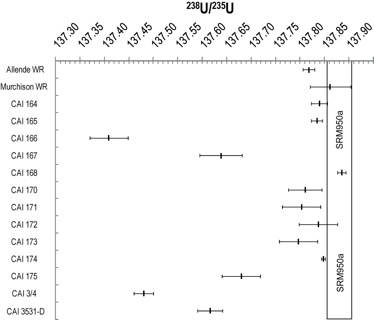2009 Annual Science Report
 Arizona State University
Reporting | JUL 2008 – AUG 2009
Arizona State University
Reporting | JUL 2008 – AUG 2009
Astrophysical Controls on the Elements of Life, Task 1: High-Precision Isotopic Studies of Meteorites
Project Summary
The evolution of habitable planets may be affected by the injection of short-lived radionuclides, produced by supernova explosions, early in solar system history. In this task we are finding evidence of such injection in some of the earliest Solar System materials (calcium-aluminum-rich inclusions) and constraining the timing of early Solar System events.
Project Progress
A major research project under Task 1 is the identification and Pb-Pb dating of calcium-aluminum-rich inclusions (CAIs) containing fractionated unknown nuclear (FUN) effects. We have begun initial documentation of a suite of CAIs from the Allende and Vigarano carbonaceous chondrites (provided to us by Dr. Glenn MacPherson), with the goal of identifying possible candidates of FUN CAIs. We have additionally begun development of the analytical protocols for high-precision measurements of Ti isotopes by laser ablation and solution analyses in the Isotope Cosmochemistry and Geochronology Laboratory at ASU. The goal of this work will be to utilize Ti isotope compositions of CAIs as an indicator for the identification of FUN CAIs.
A second project, which has important implications for the Pb-Pb dating of FUN CAIs, relates to the investigation of uranium isotope variations in CAIs. High-precision Pb-Pb dating has relied on the assumption of an invariant 238U/235U ratio, and the goal of this investigation was to verify this assumption for meteoritic materials. Therefore, graduate student Greg Brennecka, working with PI Anbar and Co-I Wadhwa (and Prof. Stefan Weyer, U. Frankfurt, Germany) analyzed thirteen different CAIs from the Allende carbonaceous chondrite and have found variations of up to ~3.5 per mil in the 238U/235U ratio (relative to the terrestrial standard; Figure 1). These variations in the 238U/235U ratio correlate with Th/U and Nd/U ratios in these CAIs, suggesting that they are the result of decay of 247Cm in the early Solar System. This work was submitted for publication as a research article in Science and is currently in revision.

Figure 1. Uranium isotope variations in meteorites. 238U/235U isotope values measured by graduate student Greg Brennecka (Brennecka et al., submitted). The box represents the measured value and analytical precision of replicate analyses of 20-100 ppb solutions of the SRM950a standard. Error bars are calculated as 2× the standard deviation (2SD) of multiple runs of each sample, when possible. The usual assumption that all meteoritic material had the same 238U/235U value is seen not to be valid.
Publications
-
Brennecka, G. A., Weyer, S., Wadhwa, M., Janney, P. E., Zipfel, J., & Anbar, A. D. (2009). 238U/235U Variations in Meteorites: Extant 247Cm and Implications for Pb-Pb Dating. Science, 327(5964), 449–451. doi:10.1126/science.1180871
-
PROJECT INVESTIGATORS:
-
PROJECT MEMBERS:
Ariel Anbar
Co-Investigator
Stefan Weyer
Collaborator
Audrey Bouvier
Postdoc
Gregory Brennecka
Graduate Student
Lev Spivak-Birndorf
Graduate Student
-
RELATED OBJECTIVES:
Objective 1.1
Formation and evolution of habitable planets.
Objective 3.1
Sources of prebiotic materials and catalysts
